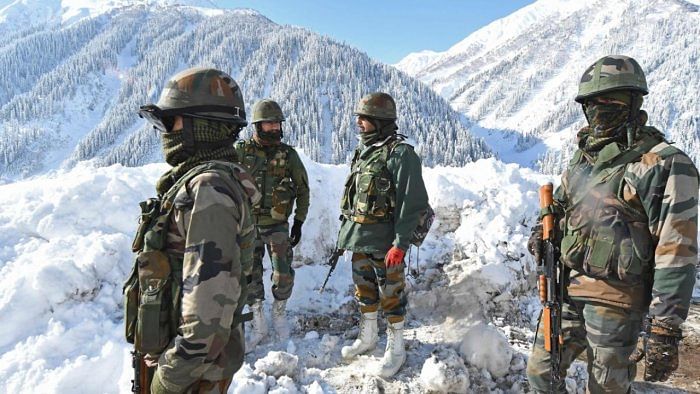
Ever since the stand-off between the Indian Army and the Chinese People’s Liberation Army (PLA) in eastern Ladakh started in April-May 2020, New Delhi has been accusing Beijing of violating the bilateral agreements signed in 1993 and 1996, by amassing a large number of troops along the disputed boundary between the two nations and making several attempts to transgress the Line of Actual Control (LAC). India repeatedly stated that China’s attempt to “unilaterally alter the status quo” along the LAC was “unacceptable”.
New Delhi’s emphasis on restoring the status quo along the de facto boundary between India and China was renewed on May 9 this year. India’s aim and intention are to restore the status quo ante as of April 2020 along its LAC in China, Gen Manoj Pande said, just days after taking over as the new chief of the Indian Army.
But is the restoration of the pre-April-2020 status quo at all possible?
“The disengagement at some of the face-off points on the LAC has resulted in the creation of buffer zones within which neither side can conduct patrolling,” says Lt Gen (retd) D S Hooda, who retired as the chief of the Northern Command of the Indian Army in 2016. “Therefore,” he tells DH
India and China had the first disengagement in Galwan Valley – the scene of the June 15, 2020, violent face-off. The Indian Army had lost 20 of its soldiers in the clash, while the Chinese PLA had much later acknowledged four casualties on its side. A fortnight later, the two sides had mutually agreed to pull back troops.
The withdrawal of the Indian Army troops from the scene of the clash to reciprocate the pull-back by the Chinese PLA as well as the moratorium on patrolling resulted in the creation of a three-kilometre-long (about 1.5 kilometres on both sides) “buffer zone” by July 6, 2020.
The negotiations between Indian and Chinese diplomats and the military commanders of India and China over the next seven months then resulted in the disengagement of troops from the northern and southern banks of Pangong Tso in February 2021.
The spurs of the mountain range on the northern bank of the Pangong Tso jut towards the lake like the fingers of the palm, with Finger 1 at the westernmost end and Finger 8 at the easternmost end. India claims that the Finger 8 marks the LAC, contrary to China’s stand that it goes through the Finger 4.
The Indian Army had earlier regularly sent soldiers from its permanent base at the Dhan Singh Thapa Post near Finger 3 for patrolling all the way up to Finger 8. But it had to suspend patrolling after a scuffle between its troops and the Chinese PLA soldiers near Finger 4 in May 2020. The PLA had later built bunkers and observation posts and deployed additional troops in the area – thus denying access to the Indian Army to its earlier patrolling limit at Finger 8.
The February 2021 deal, however, created an eight-kilometre-long buffer zone between Finger 3 and Finger 8 on India’s side of the LAC with China (on Pangong Tso northern bank), with a moratorium on patrolling by both sides. India, of course, also had to vacate the dominating heights in Kailash Range, giving up the strategic advantage it had gained over China during an overnight operation on the southern bank of the lake on August 29-30, 2020.
As the opposition parties questioned the Pangong Tso disengagement deal, Prime Minister Narendra Modi’s government clarified that India had maintained its right to patrol up to Finger 8 while clinching the deal with China. Defence Minister Rajnath Singh said in Rajya Sabha on February 11, 2021, that patrolling would be resumed, when both sides would reach an agreement. However, even as more than 18 months passed, the Indian Army has not yet resumed patrolling between Finger 3 and Finger 8.
Next came the deal for withdrawal of troops by both sides from Gogra Post a.k.a Patrolling Point 17A. The Indian Army and the Chinese PLA “ceased forward deployments in the area”, the government stated in a press release on August 6, 2021, instead of referring to a moratorium on patrolling, apparently to avoid criticism from the opposition parties. Brahma Chellaney, eminent strategic affairs expert, however, called it a ‘win-win’ deal for China, as it had created a five-kilometre-long buffer zone, with India losing access to the PP17A.
India and China late ended a year-long stalemate in negotiation and clinched another disengagement
So, the disengagement deals betwee
Gen (retd) Ved Malik, former Indian Army chief, pointed out in a recent tweet that the Chinese PLA might take advantage of patrolling moratoriums in the buffer zones. He suggested that India must continue “non-physical surveillance” over the buffer zones to pre-empt any new transgression attempts by China.
The creation of buffer zones also ended up making the restoration of the pre-April-2020 status quo difficult. China on September 9 stated that it would never accept restoration of the status quo, which had existed along the LAC before April 2020, because it had been created due to “illegal crossings” by India.
Contrary to speculation triggered by the recent disengagement at PP15 on the LAC, the Prime Minister did not have a bilateral meeting with Chinese President Xi Jinping on the sideline of the Shanghai Cooperation Organization’s summit in Uzbekistan on Friday. “Given that the India-China border is not peaceful, the relationship between the two countries is not normal,” Gautam Bambawale, New Delhi’s former envoy to Beijing, tells DH. “This state of affairs was reflected in the absence of a bilateral meeting between the two leaders in Uzbekistan.”
The stand-off along the LAC in eastern Ladakh is still not over. The Chinese PLA continues to block the Indian Army’s access to Patrol Points 10, 11, 12, 12A and 13 by deploying troops in Depsang Bulge. A similar face-off also continues in Demchok on the LAC. The two armies also continue to have a large number of troops deployed in the “depth areas” on both sides of the disputed boundary. A détente still appears distant.
